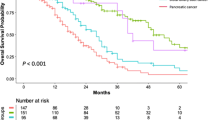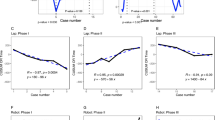Abstract
Background
The purpose of this study was to define the learning curves for laparoscopic pancreaticoduodenectomy (LPD) with and without laparoscopic reconstruction, using paired surgical teams consisting of advanced laparoscopic-trained surgeons and advanced oncologic-trained surgeons.
Methods
All patients undergoing PD without vein resection at a single institution were retrospectively analyzed. LPD was introduced by initially focusing on laparoscopic resection followed by open reconstruction (hybrid) for 18 months prior to attempting a totally LPD (TLPD) approach. Cases were compared with Chi square, Fisher’s exact test, and Kruskal–Wallis analysis of variance (ANOVA).
Results
Between March 2010 and June 2013, 140 PDs were completed at our institution, of which 56 (40 %) were attempted laparoscopically. In 31/56 procedures we planned to perform only the resection laparoscopically (hybrid), of which 7 (23 %) required premature conversion before completion of resection. Following the first 23 of these hybrid cases, a total of 25 TLPDs have been performed, of which there were no conversions to open. For all LPD, a significant reduction in operative times was identified following the first 10 patients (median 478.5 vs. 430.5 min; p = 0.01), approaching open PD levels. After approximately 50 cases, operative times and estimated blood loss were consistently lower than those for open PD.
Conclusions
In our experience of building an LPD program, the initial ten cases represent the biggest hurdle with respect to operative times. For an experienced teaching center using a staged and team-based approach, LPD appears to offer meaningful reductions in operative time and blood loss within the first 50 cases.



Similar content being viewed by others
References
Gagner M, Pomp A. Laparoscopic pylorus-preserving pancreatoduodenectomy. Surg Endosc. 1994;8:408–10.
Fleshman J, Sargent DJ, Green E, Anvari M, Stryker SJ, Beart RW, et al. Laparoscopic colectomy for cancer is not inferior to open surgery based on 5-year data from the COST Study Group trial. Ann Surg. 2007;246:655–62; discussion 62-4.
Frazee RC, Roberts JW, Symmonds RE, Snyder SK, Hendricks JC, Smith RW, et al. A prospective randomized trial comparing open versus laparoscopic appendectomy. Ann Surg. 1994;219:725–8; discussion 8-31.
Clinical Outcomes of Surgical Therapy Study Group. A comparison of laparoscopically assisted and open colectomy for colon cancer. N Engl J Med. 2004;350:2050–9.
Lacy AM, Delgado S, Castells A, Prins Ha, Arroyo V, Ibarzabal A, et al. (2008) The long-term results of a randomized clinical trial of laparoscopy-assisted versus open surgery for colon cancer. Ann Surg. 248:1–7.
Stoker DL, Spiegelhalter DJ, Singh R, Wellwood JM. Laparoscopic versus open inguinal hernia repair: randomised prospective trial. Lancet. 1994;343:1243–5.
Asbun HJ, Stauffer JA. Laparoscopic vs open pancreaticoduodenectomy: overall outcomes and severity of complications using the accordion severity grading system. J Am Coll Surg. 2012;215:810–9.
Buchs NC, Addeo P, Bianco FM, Ayloo S, Benedetti E, Giulianotti PC. Robotic versus open pancreaticoduodenectomy: a comparative study at a single institution. World J Surg. 2011;35:2739–46.
Chalikonda S, Aguilar-Saavedra JR, Walsh RM. Laparoscopic robotic-assisted pancreaticoduodenectomy: a case-matched comparison with open resection. Surg Endosc. 2012;26:2397–402.
Lai ECH, Yang GPC, Tang CN. Robot-assisted laparoscopic pancreaticoduodenectomy versus open pancreaticoduodenectomy: a comparative study. Int J Surg. 2012;10:475–9.
Zhou N-X, Chen J-Z, Liu Q, Zhang X, Wang Z, Ren S, et al. Outcomes of pancreatoduodenectomy with robotic surgery versus open surgery. Int J Med Robot. 2011;7:131–7.
Zureikat AH, Breaux JA, Steel JL, Hughes SJ. Can laparoscopic pancreaticoduodenectomy be safely implemented? J Gastrointest Surg. 2011;15:1151–7.
Correa-Gallego C, Dinkelspiel HE, Sulimanoff I, Fisher S, Viñuela EF, Kingham TP, et al. Minimally-invasive vs open pancreaticoduodenectomy: systematic review and meta-analysis. J Am Coll Surg. 2014;218:129–39.
Hernandez JM, Dimou F, Weber J, Almhanna K, Hoffe S, Shridhar R, et al. Defining the learning curve for robotic-assisted esophagogastrectomy. J Gastrointest Surg. 2013;17:1346–51.
Disclosure
Paul J. Speicher, Daniel P. Nussbaum, Rebekah R. White, Sabino Zani, Paul J. Mosca, Dan G. Blazer III, Bryan M. Clary, Theodore N. Pappas, Douglas S. Tyler, and Alexander Perez report no relevant conflicts of interest.
Author information
Authors and Affiliations
Corresponding author
Rights and permissions
About this article
Cite this article
Speicher, P.J., Nussbaum, D.P., White, R.R. et al. Defining the Learning Curve for Team-Based Laparoscopic Pancreaticoduodenectomy. Ann Surg Oncol 21, 4014–4019 (2014). https://doi.org/10.1245/s10434-014-3839-7
Received:
Published:
Issue Date:
DOI: https://doi.org/10.1245/s10434-014-3839-7




